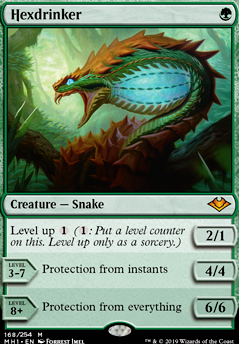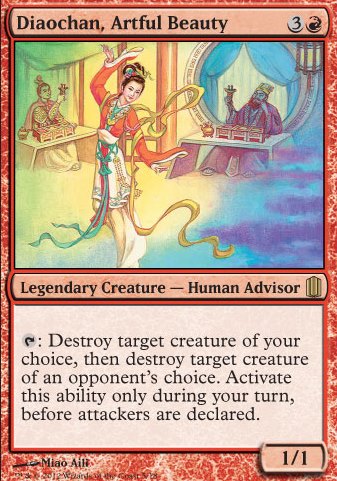


Let's face it, equipment has long been a feature of the game that R&D has had trouble balancing and we can't really blame them for that. Equipment are essentially permanent auras and as such, when designing new equipment, that feature needs to be taken into account. This has resulted in a wide spectrum in the relative power-level of certain equipment from egregiously powerful in the form of Skullclamp or Umezawa's Jitte to vastly underwhelming and unplayable on every metric. The balance is a precarious one, and unfortunately it has led to a limited cardpool from a viability standpoint. Batterskull has consistently been an example of one of the more powerful equipment available in constructed formats, however, until the unbanning of Stoneforge Mystic it lay unplayed in modern due to its high mana cost. With Stoneforge Mystic though, this drawback is removed as we can circumvent having to pay the full 5 mana for Batterskull using Stoneforge Mystic's second ability, having a 4/4 Germ potentially as soon as turn 3, an acceptable rate in the modern format.
With Batterskull as well as the swords discussed more in detail below, Stoneforge Mystic provides the deck with a tertiary way to win the game, and a method at that which does not necessitate that one is comboing-out, but rather playing "fair" magic. This flexibility serves the deck well in grindier and more interactive matchups where assembling a specific combination of cards is unrealistic in most circumstances, and serves its own purpose in keeping our opponent somewhat honest as they must always be aware that we can beat them in a multitude of ways and focusing in on one specific strategy is likely not going to be good enough. Add to this that Stoneforge Mystic has added utility in the Zirda Umbral Mantle combo, and the cost to having this tertiary plan seems small, and in many ways is actually a boon for the deck.
It can be noted here as well that, while not important to the construction of this deck, with Zirda the bounce cost for Batterskull is only , and as such, with Stoneforge Mystic it wouldn't be hard to create an environment where one can abuse a large amount of death triggers from the Germs.
The Swords



In our short discussion of the spectrum of equipment above, we alluded to the wide power-spectrum that these cards occupy within Magic. Very rarely do we get great equipment at a reasonable cost; the swords in many ways represent the pinnacle of the power of equipment as a whole. With a fair casting cost and an equally reasonable cost to equip, the swords represent both some of the most powerful and realistic options when constructing a Stoneforge Mystic package in the modern format but the question reamins then, based on the nature of the swords themselves, which one is best to play? What is most relevant and at what time? The three examples pictured above will dominate the conversation, but all the swords will be addressed, at least in part, in the following paragraphs.
Beginning with the four swords not pictured, Sword of War and Peace stands out as likely the only sword that, as of now, is not an option that would be seriously considered. The effect, while potentially powerful, is too random and inconsistent to be considered above some of the other swords. This could change if the format changes drastically and there is an increased emphasis on having a lot of cards in hand every turn, but this does not seem realistic, add to this that protection from red and white is not the most pertinent of options in the modern format, both being largely used for support, and Sword of War and Peace, while an interesting card, is not quite up to the level of some of the other swords. The two Modern Horizons swords are equally not particularly relevant. Of the two, Sword of Sinew and Steel has the most potential, however, while its protections are very good with both being colours commonly associated with removal and some of the most played creatures in the format (i.e. good against jund), its effect is sadly just too specific to be a consideration for the mainboard, the odds that one gets full value out of it each time they swing is low, maybe if Oko, Thief of Crowns was still legal then it would be a more serious consideration, but as of right now, while I could see it occupying a sideboard space in the right meta, it is not up to par with the other options. Sword of Truth and Justice suffers from the fact that it does not make an immediate impact upon swinging, in almost all cases its effect will only be relevant the following turn, at which point our opponent has had a full turn cycle to react, because of this and also because protection from blue and white is not particularly relevant (though in a heavy Snowblade meta it could be nice) Sword of Truth and Justice should not be a serious consideration. The final of the four auxiliary swords, Sword of Body and Mind, is admitedly a card that I have always been a fan of. I believe it has the potential to be very good, the protection from blue and green is not particuolarly amazing, yes this covers a large quantity of commonly played creatures in modern, specifically in green, but does not cover any commonly played removal spells. The effect equally has the potential to be very good, an extra body and a sizeable amount of mill is not the worst thing, however, in relation to the mill, there are certain matchups where this would be a considerable downside with the amount of Lurrus of the Dream-Den and Uro, Titan of Nature's Wrath decks around, not to mention the existence of decks such as Dredge and Crabvine that rely on the graveyard being full. With this in mind, Sword of Body and Mind is likely not a serious contender for the mainboard and the effect has little relevance in a sideboard.
Moving on to what are the more established and relevant swords as pictured above, the question with these three swords is not so much one regarding their playability but rather when they are to be played. Moving from right to left, the first of these swords, Sword of Feast and Famine, while immensely powerful and possessing what may be the most relevant combination of protections, is better suited to the Snowblade control builds than this build. The primary motivation for this is that this deck has a low land count, meaning there are times where the most attractive part of the sword's effect will be underwhelming, only untapping one or two lands total. For this reason, I believe the two swords to be discussed next are a better fit within the parameters this deck sets for itself, even though Sword of Feast and Famine may be the strongest overall sword within the confines of the modern format. This is not to say however that I would not consider playing Sword of Feast and Famine provided with the right set of circumstances and potentialy a greater focus on using a larger amount of mana per turn, for example if I was playing Collected Company.
Sword of Light and Shadow is very much a card that goes through phases of playability, at times appearing underwhelming, for example in a combo heavy meta Sword of Light and Shadow
is very much a card that goes through phases of playability, at times appearing underwhelming, for example in a combo heavy meta Sword of Light and Shadow can oft seem very underwhelming seeing how in those matchups its effects are hardly relevant and having protection from any number of colours is largely inconsequential. When the meta slows down however and we see an uptick in hyper-interactive decks such as jund or Snowblade, in those circumstances Sword of Light and Shadow
can oft seem very underwhelming seeing how in those matchups its effects are hardly relevant and having protection from any number of colours is largely inconsequential. When the meta slows down however and we see an uptick in hyper-interactive decks such as jund or Snowblade, in those circumstances Sword of Light and Shadow really shines based on its ability to recur threats from the graveyard, consistently being a 2 for 1, and granting protection from two colours in magic in white and black that encompass a significant proportion of playable removal in the format. In addition to this, with Lurrus of the Dream-Den Burn decks and even Jund playing Seal of Fire, having a repeatable source of lifegain that Sword of Light and Shadow
really shines based on its ability to recur threats from the graveyard, consistently being a 2 for 1, and granting protection from two colours in magic in white and black that encompass a significant proportion of playable removal in the format. In addition to this, with Lurrus of the Dream-Den Burn decks and even Jund playing Seal of Fire, having a repeatable source of lifegain that Sword of Light and Shadow provides is a difference maker.
provides is a difference maker.
The final sword, namely, Sword of Fire and Ice , has long been a staple of legacy Stoneblade builds, largely out of its ability versus the Delver decks of the format and the general preeminence of blue as a whole. In modern however, this historic level of dominance from blue based decks is not as profound and the meta has consistently been much more diverse in terms of the color-combinations we see, for this reason it is pertinent to consider other options outside of just Sword of Fire and Ice
, has long been a staple of legacy Stoneblade builds, largely out of its ability versus the Delver decks of the format and the general preeminence of blue as a whole. In modern however, this historic level of dominance from blue based decks is not as profound and the meta has consistently been much more diverse in terms of the color-combinations we see, for this reason it is pertinent to consider other options outside of just Sword of Fire and Ice , with this said Sword of Fire and Ice
, with this said Sword of Fire and Ice represents the effect that is easily the most consistently relevant, in other words, drawing a card and dealing two damage to any target is never not going to be a good thing under normal circumstances. The issue is that, while always good, in modern Sword of Fire and Ice
represents the effect that is easily the most consistently relevant, in other words, drawing a card and dealing two damage to any target is never not going to be a good thing under normal circumstances. The issue is that, while always good, in modern Sword of Fire and Ice is not always great when compared to say Sword of Light and Shadow
is not always great when compared to say Sword of Light and Shadow which can be exceptional under specific circumstances. For this reason I currently have the card in the sideboard for matchups where I am more interested in pivoting to a more midrange style Stoneblade build.
which can be exceptional under specific circumstances. For this reason I currently have the card in the sideboard for matchups where I am more interested in pivoting to a more midrange style Stoneblade build.









![[Primer] - Ad Nauseam Combo [[Procellam Legit]] thumbnail](http://static.tappedout.net/chart/20-55-25-0-0-small.png)
![Lightning Storm feature for [Primer] - Ad Nauseam Combo [[Procellam Legit]]](http://static.tappedout.net/mtg-cards-2/coldsnap/lightning-storm/lightning-storm-cropped.jpg)

























